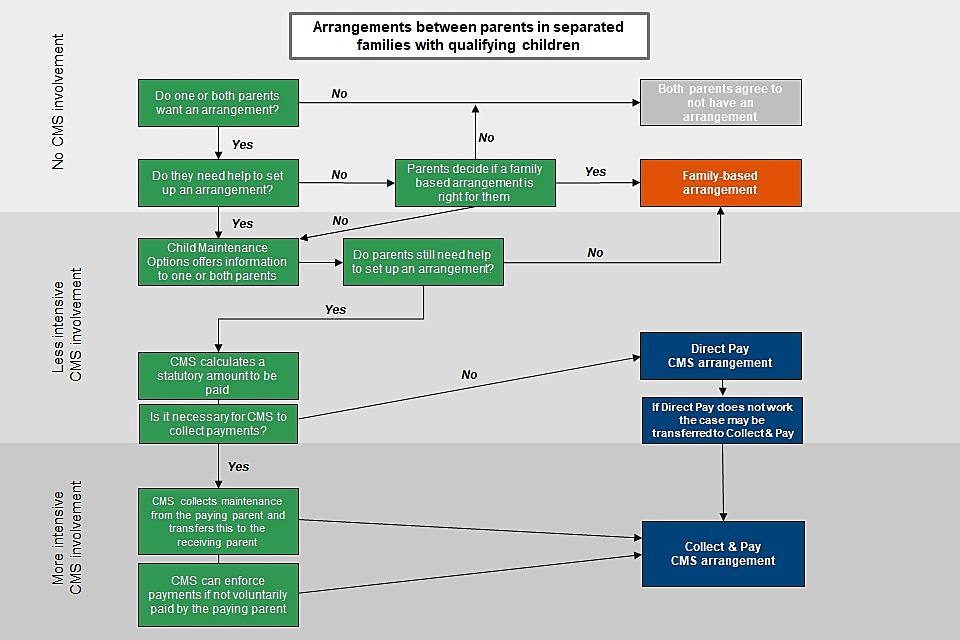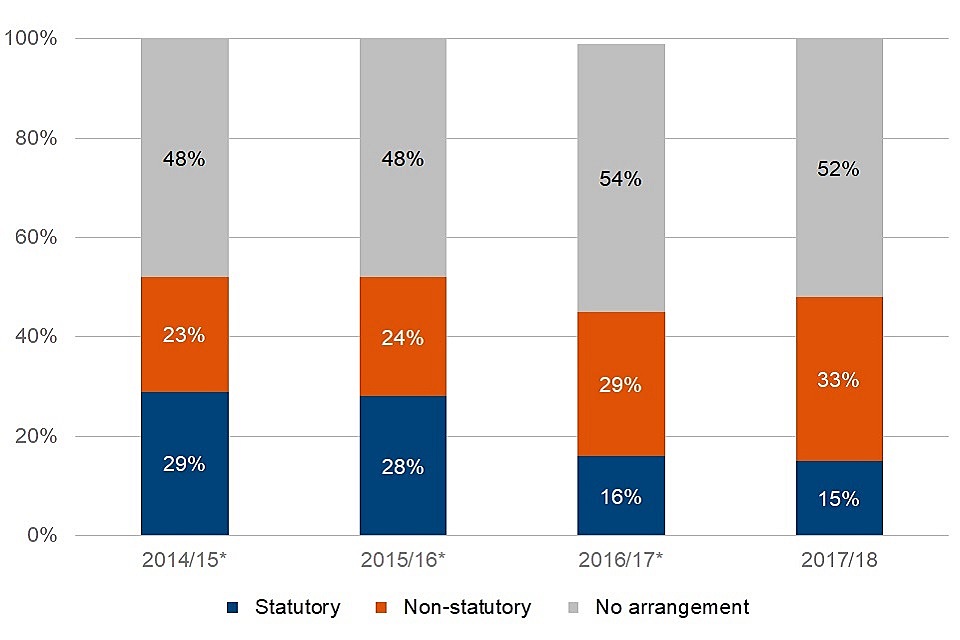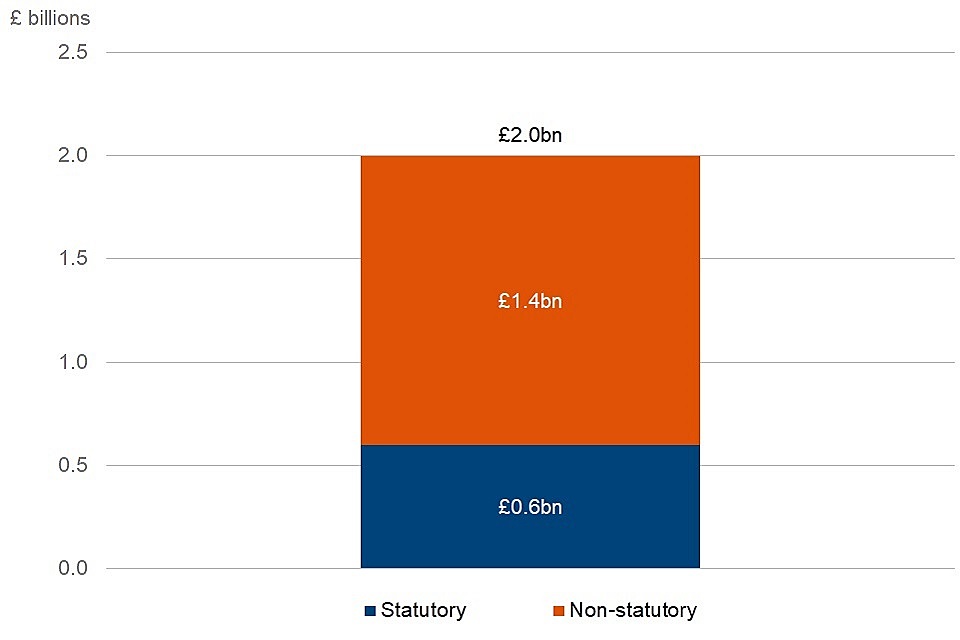Estimates of the separated family population statistics: April 2014 to March 2018
Published 26 March 2020
Applies to England, Scotland and Wales
The latest release of these statistics can be found in the collection of Separated families statistics.
This is an annual release of statistics on separated families in Great Britain.
These statistics have been developed using guidelines set out by the UK Statistics Authority and are official statistics undergoing development. They have therefore been designated as experimental statistics.
This release includes revisions to previously published statistics.
The next release is planned for March or April 2021.
1. Introduction
The Department for Work and Pensions’ (DWP) Single Departmental Plan includes an objective to increase every child’s opportunity to succeed by helping separated parents agree effective child maintenance arrangements. This publication provides statistical estimates relating to separated families and their child maintenance arrangements.
These statistics provide estimates of the following for each year from 2014/15 to 2017/18:
- the total number of separated families in Great Britain
- the number of children in those families
- the proportion of separated families with child maintenance arrangements of various types (the effectiveness of child maintenance arrangements is beyond the scope of these statistics)
The latest release also provides the following estimates for the first time:
- breakdowns of the resident parent population by age and gender for the period 2015/16 to 2017/18
- the total amount of child maintenance payments received by resident parents by arrangement type in 2017/2018
- the impact of child maintenance payments on the number of children in low income households in 2017/2018, by family type
It should be noted that there is no requirement for separated families to have a child maintenance arrangement and some families may not want an arrangement. If parents do want an arrangement they may be able to agree this themselves without the involvement of the Child Maintenance Service (CMS). Arrangements made in this way are called non-statutory arrangements. Where parents want an arrangement but need help with this, the Child Maintenance Options service is available to provide support.
2. Main stories
In 2017/18:
- there were approximately 2.4 million separated families in Great Britain including 3.5 million children
- 48% of separated families had a child maintenance arrangement
- the resident parents in separated families received approximately £2 billion in child maintenance payments
- child maintenance payments reduced the number of children living in low income households – the greatest impact was on absolute low income after housing costs, with 120,000 fewer children in low income households based on this measure as a result of child maintenance payments
In 2015/16 to 2017/18:
- approximately 90% of resident parents in separated families were female and approximately 90% were under 50 years of age
3. What you need to know
Definitions
The key definitions and terminology used within these statistics are explained below.
A separated family
A separated family is defined as one resident parent, one non-resident parent and any biological or adopted children they have between them who are either under 16 or under 20 and in full-time non-tertiary education.
A resident parent
A resident parent is the parent who has main day-to-day care of any relevant children and who may potentially be eligible to receive child maintenance.
A non-resident parent
A non-resident parent is the parent who does not have main day-to-day care of any relevant children and who may potentially be required to pay child maintenance.
Child maintenance arrangement
There are two main types of child maintenance arrangement: statutory arrangements and non-statutory arrangements (see below). Separated families may have more than one type of arrangement.
Statutory child maintenance arrangements
Statutory child maintenance arrangements are those which have been arranged with the CMS or its predecessor, the Child Support Agency (CSA).
Non-statutory arrangements
Non-statutory arrangements include all other arrangements such as:
- voluntary financial arrangements which involve direct monetary payments between parents where the CMS or CSA have not been involved;
- voluntary non-financial arrangements involving payments in kind
- other types of arrangements including shared care arrangements
- court orders requiring parents to make financial payments
Child Maintenance Options
Child Maintenance Options is a free service providing impartial information and support to help separated parents make decisions about their child maintenance arrangements. 83% of people who contacted Child Maintenance Options in February to April 2019 had an arrangement 6 months later and around a quarter of these had a non-statutory, family-based arrangement.
Child Maintenance Service (CMS)
The CMS was introduced in December 2012. It replaced the CSA and is for separated parents who can’t arrange child maintenance between themselves. Parents can ask the CMS to calculate the amount of maintenance to be paid and, if necessary, to help manage and collect payments. Up until the end of December 2018 some families still had a child maintenance arrangement with the CSA. All the CSA cases with on-going liabilities have now closed, with parents having had the option of setting up a statutory arrangement with the CMS or a non-statutory, family-based arrangement.
An illustrative example showing how separated families might select an arrangement

Flowchart: “If parents want a child maintenance arrangement they may be able to agree this themselves without the CMS. If they need help with this, CM Options can provide support. CMS is for parents who can’t arrange maintenance between themselves
Low income
A household is said to be in relative low income if their equivalised income is below 60% of median household income, while they are said to be in absolute low income if their equivalised income is below 60% of the 2010/11 median household income adjusted for inflation. Both relative and absolute low income are estimated before and after taking housing costs into account for comparison.
4. Separated families and their child maintenance arrangements
It is estimated that in 2017/18 there were approximately 2.4 million separated families in Great Britain including 3.5 million children.
Figure 1: Separated families by child maintenance arrangement type*, 2014/15 to 2017/18

Figure 1: In 2017/18, 48% of separated families had a child maintenance arrangement. Whilst this is 4 percentage points lower than in 2014/15 and 2015/16, the proportion with an arrangement increased by 2 percentage points between 2016/17 and 2017/18
Sources: Family Resources Survey (FRS); CMS and CSA administrative databases (see the accompanying tables for full data.).
Notes about Figure 1:
-
Figures relating to 2014/16, 2015/16 and 2016/17 have been revised and differ from those published in the previous release in this series. These revisions are the result of a number of methodological improvements. Read the background information and methodology note for more information about this.
-
For simplicity, the statutory arrangement group includes families who have both statutory and non-statutory arrangements. See the accompanying tables for full data.
- The statistical significance of year-on-year changes cannot be assessed as estimates are derived from various sources. (See the background information and methodology note).
- Totals may not sum to 100% due to rounding.
In 2017/18, 48% of separated families had a child maintenance arrangement. Whilst this is 4 percentage points lower than in 2014/15 and 2015/16, the proportion with an arrangement increased by 2 percentage points between 2016/17 and 2017/18.
Between 2015/16 and 2017/18, in line with policy intent, the proportion of separated families with a statutory arrangement fell and the proportion with a non-statutory arrangement increased.
Between 2014/15 and 2016/17, statutory child maintenance moved from the CSA to the CMS. CSA cases began closing and under CMS more freedom and support was provided to enable parents to choose the arrangement that works best for them. This could be a statutory arrangement or a non-statutory arrangement, and there is no requirement for parents to have an arrangement.
The CSA cases were closed in groups. Those closed first were the simpler cases, such as those with no liability in place. The last cases to close were more complex, such as those where enforcement action was on-going. Any fall in the proportion of separated families with a statutory arrangement may be partly due to the closure of historical CSA cases that were non-compliant or had no ongoing liability.
See accompanying tables for full data. It is not possible to assess whether year-on-year changes are statistically significant as the estimates are derived from various data sources (see the background information and methodology note).
5. The impact of child maintenance payments on the number of children in low income households
Figure 2: The total amount of child maintenance payments received by resident parents by child maintenance arrangement type, 2017/18

Figure 2: In 2017/18, the resident parents in separated families received approximately £2 billion in child maintenance payments. 70% of these payments related to non-statutory child maintenance arrangements, with 30% relating to statutory arrangements
Sources: Family Resources Survey (FRS); CMS and CSA administrative databases. See the accompanying tables for full data.
It is estimated that in 2017/18 the resident parents in separated families received approximately £2 billion in child maintenance payments. Approximately 70% of these payments related to non-statutory child maintenance arrangements, with approximately 30% relating to statutory arrangements.
Table 1: The impact of child maintenance payments on the number of children in low income households, 2017/18
| Definition of low income | Net impact on the number of children in low income households (thousands) |
|---|---|
| Relative low income (before housing costs) | -60 |
| Relative low income (after housing costs) | -100 |
| Absolute low income (before housing costs | -60 |
| Absolute low income (after housing costs | -120 |
Source: Family Resources Survey (FRS). See the accompanying tables for full data.
Notes about Table 1:
- Estimates are rounded to the nearest 20,000.
Child maintenance payments reduced the number of children living in low income households. The greatest impacts were on children in absolute low income after housing costs, with 120,000 fewer children in low income households on this measure as a result of child maintenance payments, and on those in single parent families.
6. About these statistics
These statistics have been developed using guidelines set out by the UK Statistics Authority and are official statistics undergoing development. They have therefore been designated as experimental statistics. We plan to publish these statistics on an annual basis and will continue to explore expanding their scope to help to meet user needs where reliable estimates can be obtained. Users are invited to comment on the development and relevance of these statistics at this stage and can send feedback to: cm.analysis.research@dwp.gov.uk.
These GB–level statistics are estimates based primarily on data from the Family Resources Survey (FRS). The FRS is based on a representative sample of around 19,000 United Kingdom (UK) households. The FRS is a continuous survey which collects information on the income, characteristics and circumstances of individuals living in a representative sample of private households in the UK. FRS respondents are asked about the relationships within their household and any child maintenance arrangements they may have. Their responses are used to determine whether they are members of a separated family, how many children are in that family, the types of child maintenance arrangements they have (if any) and the amount of maintenance they receive.
Where feasible and appropriate, FRS responses regarding child maintenance arrangements are checked for accuracy against the DWP’s CMS and CSA administrative databases and an adjustment for the under-reporting of statutory and non-statutory arrangements is applied. FRS data regarding the reasons for which some separated families have no arrangement are not currently available.
Estimates of the total amount of child maintenance payments received by resident parents are based on a combination of administrative data and unadjusted FRS data.
Estimates of the impact of child maintenance payments on the number of children in low income households are obtained by applying the Household Below Average Income (HBAI) methodology to unadjusted FRS data.
More information about the methodology used to produce these statistics and its limitations can be found in the accompanying background information and methodology note.
Rounding
Figures are rounded to the nearest 100,000, except those relating to the impact of child maintenance payments on the number of children in low income households which are rounded to the nearest 20,000. Monetary amounts are rounded to the nearest hundred million pounds. Percentages are calculated using figures prior to rounding and are rounded to the nearest integer. Totals may not sum due to rounding.
Changes made to this publication
The latest release provides the following estimates for the first time:
- breakdowns of the resident parent population by age and gender for the period 2015/16 to 2017/18
- the total amount of child maintenance payments received by resident parents by arrangement type in 2017/18
- the impact of child maintenance payments on the number of children in low income households in 2017/18, by family type
Figures relating to 2014/16, 2015/16 and 2016/17 have been revised and differ from those published in the previous release in this series. These revisions are clearly indicated and are the result of a number of methodological improvements (see Background information and methodology note).
The overall impact of these changes is that estimates of the following for 2014/15 to 2016/17 have been revised downwards:
- the total number of separated families in Great Britain (downward revisions range from 4-8%)
- the number of children in those families (downward revisions range from 8-10%)
- the proportion of separated families with a child maintenance arrangement of any type (downward revisions range from 2-3 percentage points, driven largely by revisions to estimates of the proportion with a statutory arrangement)
These changes do not affect the overall trends for these statistics and revisions relating to 2016/17 were smaller than those relating to 2014/15 and 2015/16.
Planned changes
These statistics are estimates derived using an experimental methodology which will continue to be reviewed and, where feasible, improved. Any future revisions will be clearly indicated and explained in the relevant publication.
In line with the current HBAI methodology, estimates of the impact of child maintenance payments on the number of children in low income households do not take some types of child maintenance payment into account. The proportion of child maintenance payments that are not taken into account is relatively small and we aim to improve the methodology to capture child maintenance payments more comprehensively in future.
7. Where to find out more
More information about these statistics can be found in the accompanying Background information and methodology note and Data tables.
The DWP Single Departmental Plan includes an indicator based on these statistics (“the proportion of separated families with a child maintenance arrangement”).
Read more information about the Households Below Average Income methodology.
ISBN 978-1-78659-220-0
